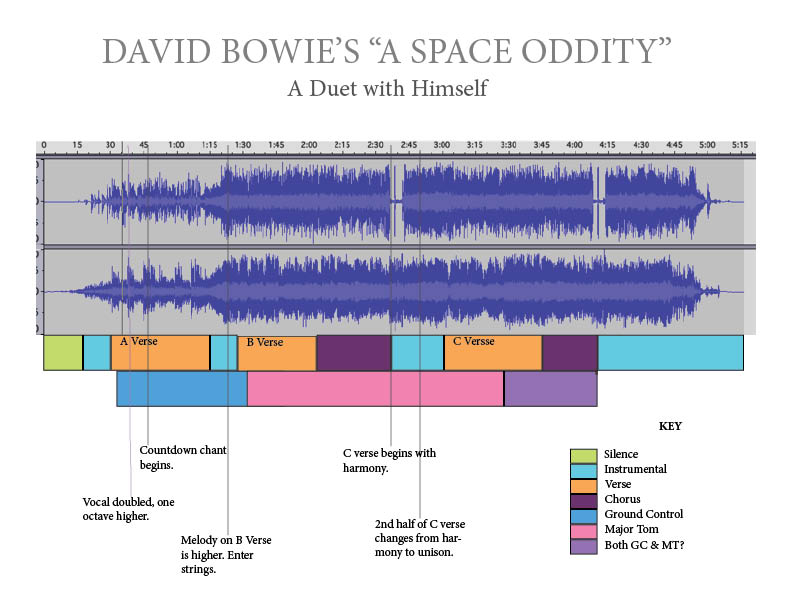
I made my first infographic. Or a stab at one. My students are making some, so I thought I should try it too. My students didn’t know Bowie’s “A Space Oddity.” I tried to hide my shock. But now they know a lot about it.
Bowie recorded “A Space Oddity” in 1968. It was his first real hit record–in 1969 in Britain and 1972 in the U.S. Famously, it tells the story of Major Tom, a fictional version of an early astronaut. In 1961, the first human, Russian Yuri Gagarin, traveled to space and orbited the earth. After that, the Americans and the Russians entered a “space race,” vying for a series of firsts, including getting a human to the surface of the moon.
Bowie wrote his first hit in response to the space race–and Stanley Kubrick’s film 2001: A Space Odyssey.* I started my infographic to test a hypothesis: Bowie used the eeriness of the first humans in space as an early experiment with performing as a persona. Throughout his career, he’d become famous for his theatrical personas, including Ziggy Stardust, The Thin White Duke, and Alladin Sane. I learned from Chris O’Leary’s detailed analysis of the track that it was originally written as a duet. When he recorded it, Bowie turned it into a duet with himself.
Through the process of composing the infographic, I became more convinced the song is a duet between Bowie and Bowie. But the experiment is more complex than I imagined at first. The second line of colored bars represents the song’s narrators, or personas. Blue is the operator at Ground Control, and pink Major Tom “floating in his tin can.” The purple bar represents a second hypothesis. After Major Tom sings “Tell my wife I love her very much, she knows,” the persona shifts.
At first it seems obvious that Ground Control sings the heartbreaking second half of the verse: “Your circuit’s dead, there’s something wrong / Can you hear me Major Tom?” But what if both narrators are singing? What if Major Tom is singing along with Ground Control? While Ground Control addresses these panicked messages to him, Major Tom joins in. “She knows” might signal the fact that his wife knows he loves her AND that she’s heard the news that something has gone horribly wrong. This is interpretive speculation, but if it’s true, the double narrators amplify the deep sadness of the story. Major Tom sings with full awareness that nobody on earth can hear him.
Throughout his career, Bowie was reverent about well-crafted pop songs; he also loved to experiment with form. You can already see that with “A Space Oddity.” The verses are catchier than the chorus. We get two full verses and a bridge before the chorus even comes in. Bowie is subtly upending the logic of the traditional pop hit, partly to emphasize the dialogue, or duet, between Ground Control and Major Tom.
Some of the complexities of the method become clear when you examine his various approaches to the vocal. The melody evolves from verse to verse. The first begins low and mysterious. After the first few lines, he doubles his voice, alternating harmony with singing the same melody in two octaves. The higher parts presage the higher, more emotive vocal of the B verse. In the C verse, the harmony continues for the first half, but then fades, with an intimate delivery of the line “Tell my wife I love her very much.” After this, the vocal is doubled again–this time in unison, duplicating the same melody. There’s a full two minutes of music after the final verse. As the vocal fades, his duet with himself feels unresolved as it’s overtaken by the chaos of the instrumental outro. Like Major Tom and Ground Control, we don’t know what’s going to become of the astronaut in his “tin can,” but the signs are not good.
*A literary note: Kubrick’s title is a play on Homer’s The Odyssey. He takes the classic tale of a warrior’s journey and gives it a bleak, futuristic twist. Bowie substitutes the soundalike, “oddity,” a wry contribution to literary history in keeping with his various outsized personas.
Acknowledgements
Chris O’Leary’s analysis of “A Space Oddity,” on his blog Pushing Ahead of the Dame, Bowie Song by Song, helped me understand the structure of the song. I got inspiration for the form of my infographic from Ethan Hein’s “track analysis” of Childish Gambino’s “This Is America.”
Check out the song yourself. If you have other interpretations, I’d love to hear about them in the Comments section. Watching Bowie perform it is pretty moving.

